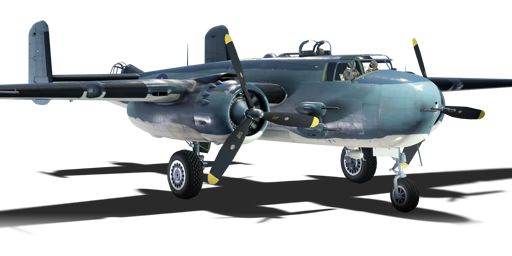



The PBJ-1H is a American strike aircraft. It was introduced in Update 1.41.
The PBJ-1H is U.S. Navy variant of the B-25 which was operated by the U.S. Marine Corps as a ground attacker. This aircraft is a powerful ground strafing machine and due to the weapons package built-in, it can be viewed as a gunship. With eight 12.7 mm machine guns and a 75 mm cannon, most light ground targets such as AAA positions and Artillery positions can be destroyed. The 75 mm T13E1 cannon is similar to the 75 mm M3 on the Sherman tank and shares its powerful support capability. With Armoured Targets belt loaded, it can knock out light pillboxes with ease and greater accuracy than bombs in Realistic and Simulator modes. It is even effective against light and medium tanks, although the low fire rate makes it less than ideal for strafing several targets in a short target window. It is recommended to use the virtual cockpit view to aim the main gun. The 12.7 mm guns should be mainly utilized against "soft" targets such as armoured Cars, AA and artillery positions, and the 75 mm Gun against hardened targets such as light pillboxes and tanks. That said, the concentrated MG fire can also be used to destroy light pillboxes (with practice), though will require significant ammo usage to do so.
Despite armament differences, the airframe of the PBJ is still that of the B-25. While this means that it will have a relatively large number of defensive weapons, it also means that it is relatively sluggish compared to other close-support aircraft. It also presents a relatively large and slow-moving, though semi-well-defended target. Beware all variants of the Bell P-39 Airacobra, P-63 Kingcobra, P-47 Thunderbolt, all variants of the Me 410 and the Yak-9T; these aircraft can destroy your aircraft without much difficulty, whereas you will have a difficult time expending numerous 12.7 mm rounds trying to knock them out of the sky or off your tail.
This aircraft has several weaknesses in which the pilot must be aware of which could be exploited by attacking aircraft. First, the twin rudders in the tail section create gunner dead zones. The rudders will prevent the side gunners and to an extent the dorsal gunner from firing on an enemy attacking from the shadow of either of these two spots. The tail gunner should be able to neutralize this weakness as long as he has not been knocked out. The underside of the aircraft is especially vulnerable as there is no ventral turret and the tail gunner, side gunners only have a limited downward angle in which they can shoot, so it may be best to fly as low as possible in certain circumstances. Even with the great fire-power utilized on this aircraft, the pilot's best bet will be to operate under fighter cover when possible.
Other differences from the B-25 are the smaller bomb payload, attacker spawn location (lower altitude than bombers) and the lack of a bomb-sight view for precision bombing.
flaps
flaps
flaps
brake
| Belt | Belt filling | Armor penetration (mm) at a distance: | |||||
|---|---|---|---|---|---|---|---|
| 10 m | 100 m | 500 m | 1000 m | 1500 m | 2000 m | ||
| AP-T/HEI-T | 104 | 102 | 93 | 84 | 75 | 68 | |
| AP-T | 104 | 102 | 93 | 84 | 75 | 68 | |
| HEI-T | 10 | 10 | 10 | 10 | 10 | 10 | |
| Belt | Belt filling | Armor penetration (mm) at a distance: | |||||
|---|---|---|---|---|---|---|---|
| 10 m | 100 m | 500 m | 1000 m | 1500 m | 2000 m | ||
| T/Ball/Ball/I/AP-I | 28 | 26 | 18 | 11 | 7 | 4 | |
| AP-I/AP-I/AP-I/T/I | 28 | 26 | 18 | 11 | 7 | 4 | |
| T/AP/AP/AP/AP-I/I | 30 | 27 | 20 | 13 | 9 | 6 | |
| T/T/T/T/T/AP-I | 28 | 26 | 18 | 11 | 7 | 4 | |
| AP/AP-I/AP-I/I/I | 30 | 27 | 20 | 13 | 9 | 6 | |
| Belt | Belt filling | Armor penetration (mm) at a distance: | |||||
|---|---|---|---|---|---|---|---|
| 10 m | 100 m | 500 m | 1000 m | 1500 m | 2000 m | ||
| T/AP/I/AP-I | 30 | 27 | 20 | 13 | 9 | 6 | |
| AP/AP/AP/T | 30 | 27 | 20 | 13 | 9 | 6 | |
| AP-I/AP-I/AP-I/T | 28 | 26 | 18 | 11 | 7 | 4 | |
| Belt | Belt filling | Armor penetration (mm) at a distance: | |||||
|---|---|---|---|---|---|---|---|
| 10 m | 100 m | 500 m | 1000 m | 1500 m | 2000 m | ||
| T/AP/I/AP-I | 30 | 27 | 20 | 13 | 9 | 6 | |
| AP/AP/AP/T | 30 | 27 | 20 | 13 | 9 | 6 | |
| AP-I/AP-I/AP-I/T | 28 | 26 | 18 | 11 | 7 | 4 | |












Flight performance | |
|---|---|
Survivability |
|---|
Weaponry | ||
|---|---|---|